Best Chatbot Tools to Improve Customer Service in 2024
Check out this list of popular chatbot software in the market, you can choose the right one that meets your business needs, preferences, and budget.
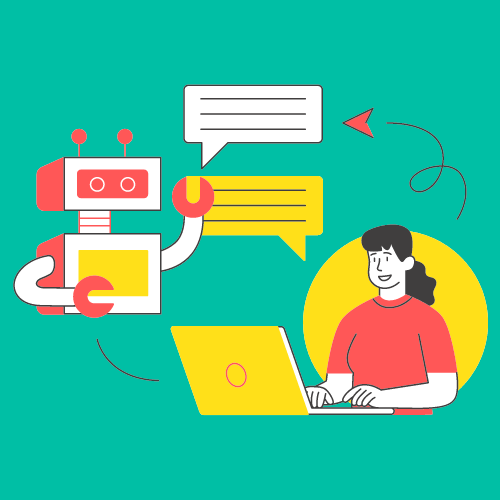
Today’s savvy customers are busy, and providing them with instant responses is key.
More than 82% of them expect a quick answer from the support team they reached out to. Well, who wants to wait an hour just to get a simple, probably frequently-asked question like, “do you ship worldwide?”
Thanks to chatbots. You don’t have to burn the customer support team out to provide round-the-clock service.
No matter what time it is and where your potential customers come from, this powerful tool can help you answer queries in a matter of seconds.
To take full advantage of it, you’ll need robust chatbot software, and we’ve listed some of the best of them below.
Why Chatbots?
Let’s brush up on the basics first. Why should chatbots be a must-have in your marketing tool in the first place?
We’ve slightly mentioned that it can help answer queries immediately.
Here are some other benefits you’ll get if you add a chatbot to your marketing arsenal.
Cut the marketing cost
You don’t need to expand your customer support team by hiring more people just to take the service to the next level. Chatbots can do that for you.
It can take on multiple tasks, from appointment scheduling to lead qualification and even content personalization. You’ll be able to focus your budget on other important marketing areas with the help of a chatbot. For more specialized queries, integrating an answering service ensures customers always get the help they need.
Think long-term relationship
When customers get their questions answered quickly, they tend to develop a good relationship with the company.
It helps build trust and credibility, which are essential in any business-customer interaction.
By providing timely support, you can turn a one-time customer into a lifelong fan of your brand.
Increase your team’s productivity
Since chatbots can help with mundane, repetitive tasks, it frees up your team’s time so they can focus on other important tasks that require real human interaction and creativity, like developing new marketing strategies or reaching out to potential prospects.
Close more deals
Not only will a chatbot help you answer some queries in seconds, but it will also be a digital assistant for your potential customers to do something, from signing up to your email list to purchasing a product.
It walks them through a step-by-step guide and even sends them a tutorial or training video. This helps you to get more deals and conversions.
The difference between Chatbots and Conversational AI
Before we go into the top chatbot solutions on the market, we also want to give a short introduction about what Conversation AI is and how that is different from Chatbots. In short, a Conversational AI solution is more sophisticated and a natural next step when you want to power up your customer service and chatbots can’t get the job done.
Conversational AI: What is it?
Any system that allows users to speak or type and then receive a response is considered conversational AI. Conversational AI comes in various forms, including those used by conventional chatbots, smart home assistants, and some customer support software.
However, in this context, we’re using the term especially to describe sophisticated communication software that adapts over time to enhance interactions and choose when to pass things forward to a human response.
Natural language understanding (NLU) is a major component of conversational AI and is its key differentiator.
key attributes of conversational AI:
Conversational AI’s key attributes include:
- Systems for training: Supervised and semi-supervised learning options let your customer care representatives go over NLU findings and offer comments. This gradually changes the AI so that it can comprehend and react to the particular preferences of your business.
- User-friendly interfaces: Because AI has a contemporary, graphical interface, anyone can understand or upgrade the system without needing to know how to code.
- Extensions: Extensions are conversational plug-and-play modules that can offer immediate assistance for daily needs without requiring user-driven AI development. See what you may expect by integrating a Conversational AI platform with robotic process automation (RPA) for quicker customer service in the video below.
- Automated testing: This can assist you to make sure that, even after altering your AI, your business objectives are still being met.
- Multi-language: Conversational AI systems can operate simultaneously in several languages while utilizing the same general logic and connections.
8 Top Chatbot Software in the Market
Now that we know the reasons why you need a chatbot, it’s time to move on to the next step: finding the right software. Here are some of our top picks.
1. Drift
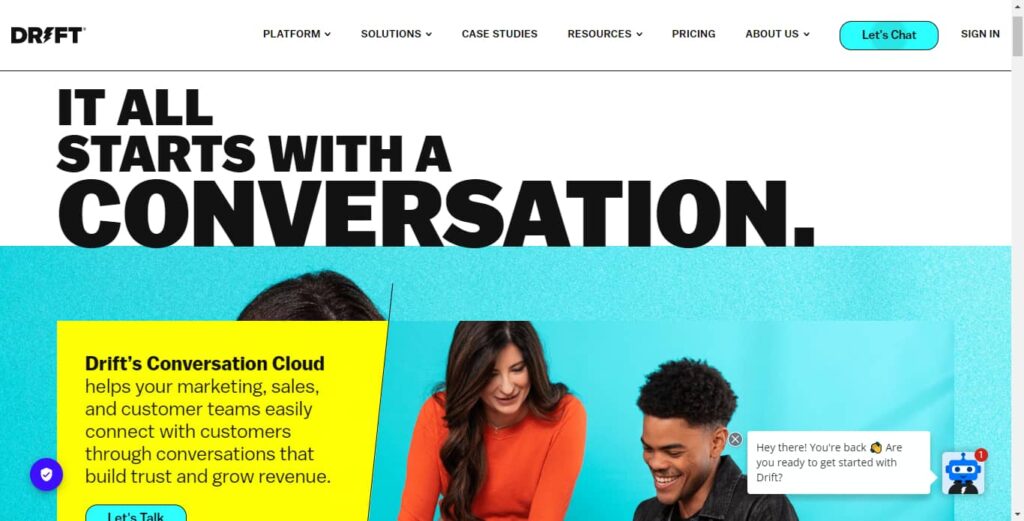
When it comes to providing an amazing customer experience, Drift is one of the top chatbot software you can find in the market.
It has a wide range of features that allow you to do things, from qualifying leads to scheduling appointments. You can also use it to send personalized messages to your potential customers based on their behavior on your website.
What makes Drift stand out is that it’s very easy to use. You don’t need any coding skills to create a chatbot. Just enter the questions you want your chatbot to answer, and you’re good to go.
It also has a visual builder that makes it easy to design your chatbot’s conversation flow.
2. Intercom
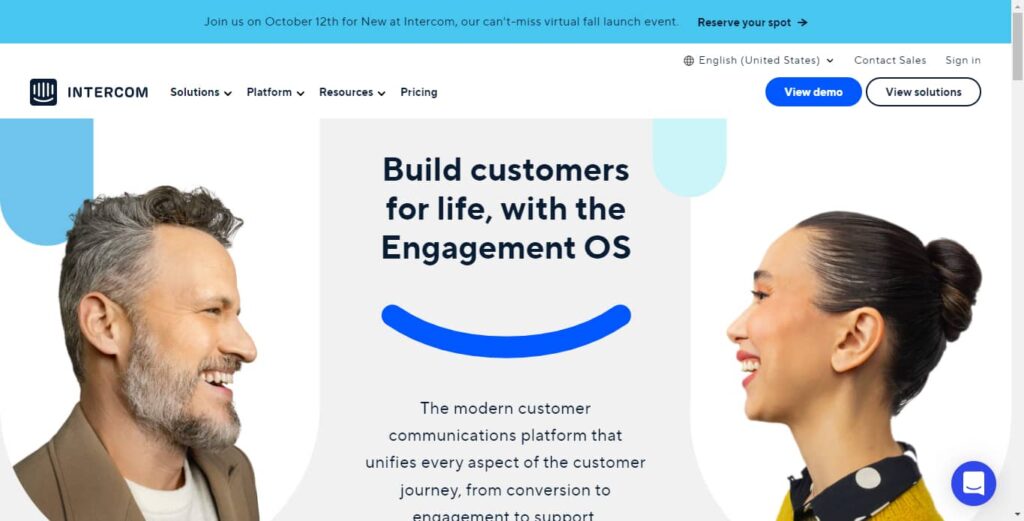
Intercom is one of the most popular customer support tools. And for a good reason.
It has a wide range of features that allow you to do things like qualifying leads, providing customer support, and even sending targeted messages.
What sets Intercom apart is its ability to segment your audience so you can send them different messages based on their behavior.
For example, you can send a message to people who haven’t used your product in a while to try and get them to come back.
3. Tidio
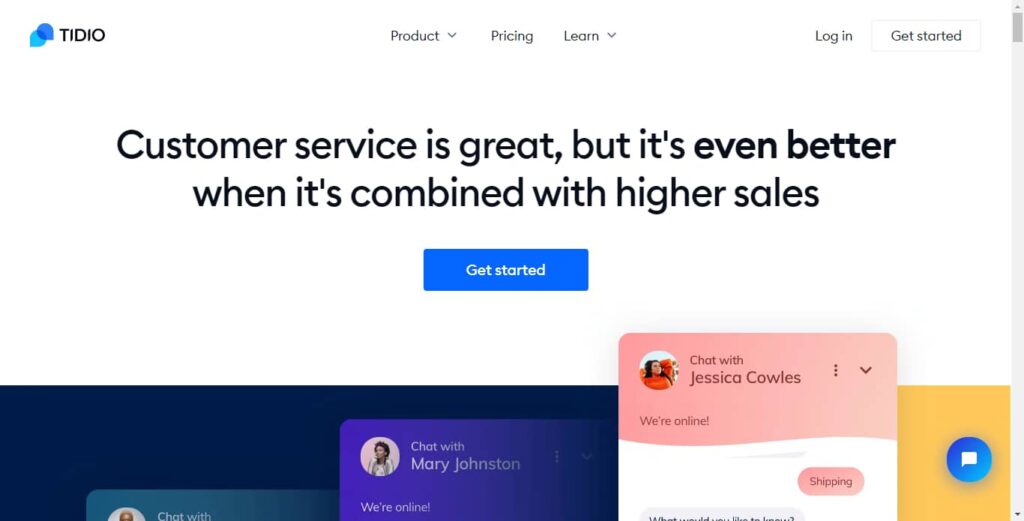
Tidio is a good option if you’re looking for straightforward chatbot software but still has all the chatbot-building features you need. You can use this software not only for your website but also for Facebook Messenger as well.
One stand-out feature this software offers is the flexibility when it comes to the pricing options. They give users the chance to pay for only the features they need to use. Not to mention that the interface is user-friendly, too– making it a worth-considering option for small businesses.
4. LivePerson

LivePerson is probably the most robust and feature-packed chatbot software on this list. There’s a reason why it’s in our top spot. LivePerson’s chatbot software can integrate with your messaging apps, like Facebook Messenger, WhatsApp, and WeChat.
You can fully customize your chatbot in terms of its personality, language, tone, and even name. You can also set triggers and conditions that will allow you to automate the response flow.
This feature, along with the ability to integrate with third-party apps, allows businesses to create highly customized engagement experiences for customers.
The only caveat is that all of this power comes at a high price. Beginner and small-scale businesses might find LivePerson a bit overkill for their needs.
5. Freshchat
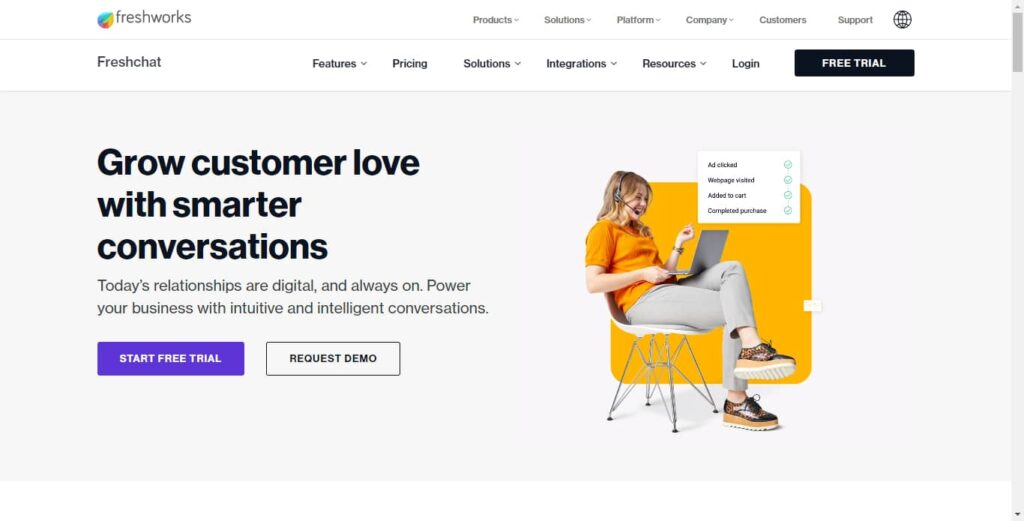
Freshchat is a reasonably priced, feature-rich, and robust business chatbot software that can fit into any business’s budget. Freshchat allows you to create a comprehensive and diverse bot that can help you manage your online presence and drive sales.
You can use the bot to provide personalized recommendations, manage your social media channels, and even process orders. This is one of the most feature-packed and versatile chatbot software on our list.
However, it does lack features like real-time communication and integrations with other apps. So if those are important to you, you might want to move on and look at another option on this list.
6. ManyChat
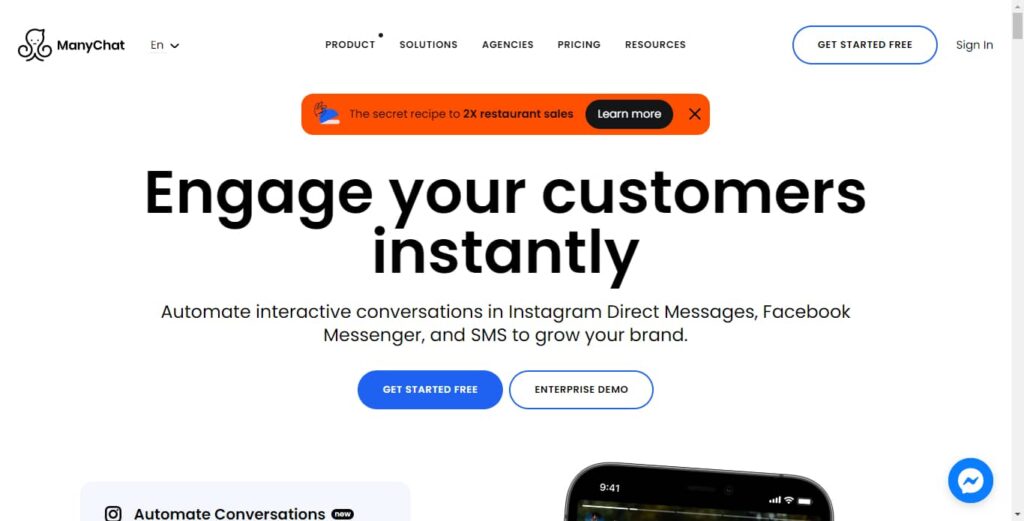
ManyChat is a robust, easy-to-use, and reasonably priced chatbot software that helps businesses create and engage with customers through Facebook Messenger.
ManyChat helps businesses create branded chatbots to engage with their customers through Facebook Messenger and other messaging apps.
The software comes with features like built-in analytics, an easy-to-use interface, chatbot templates, and integrations with third-party apps.
ManyChat is a great choice if you’re looking for an affordable, easy-to-use, quick-to-implement chatbot software. It has all the core features you need to create a fully functional chatbot. Although, at a quick glance, it doesn’t look as robust as LivePerson.
7. Chatfuel

If you’re looking for a quick way to create a simple and no-frills chatbot, then Chatfuel is a great option. You can create a basic chatbot that can help you manage your online presence for as little as $9 per month.
This is the most basic version of the Chatfuel chatbot software. It is best suited for businesses that want to create a simple chatbot without much technical expertise quickly.
If you’re looking for high-end, feature-rich, and robust chatbot software, you might want to skip Chatfuel. It has some limitations and doesn’t allow you to create a fully custom bot.
8. MobileMonkey
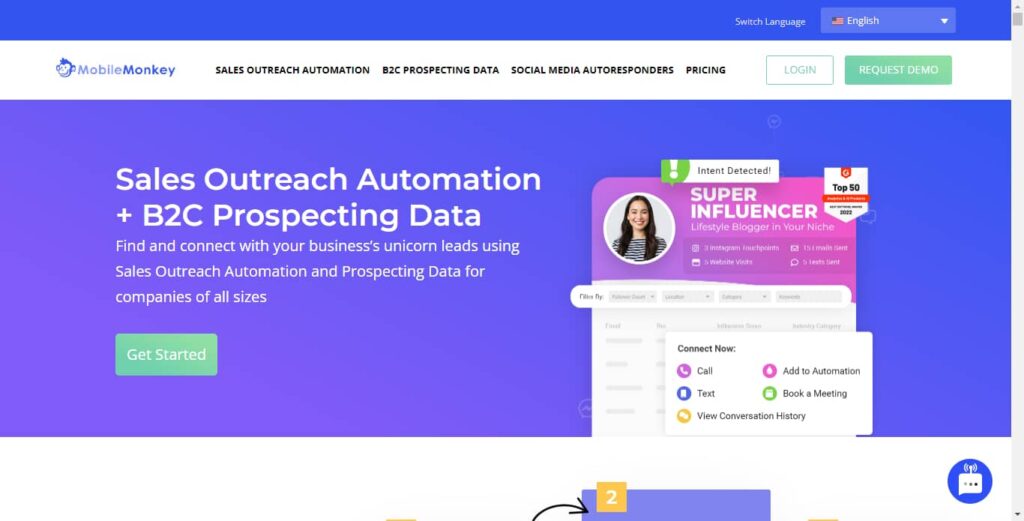
MobileMonkey is an all-in-one web and app builder that lets you create a fully functional bot using its drag-and-drop builder. It comes with a set of pre-built chatbot templates that you can customize to create a functional bot.
However, its real strength lies in the ability to create a custom chatbot from scratch. You can use its robust set of tools and features to design a fully custom bot that can help you manage your online presence and drive sales.
MobileMonkey is a great option if you’re looking for robust and fully customizable chatbot software. However, if you just want to create a basic chatbot, you’ll find its features to be a bit overwhelming and overkill.
How to Start Implementing Chatbot Tools to Improve Customer Service
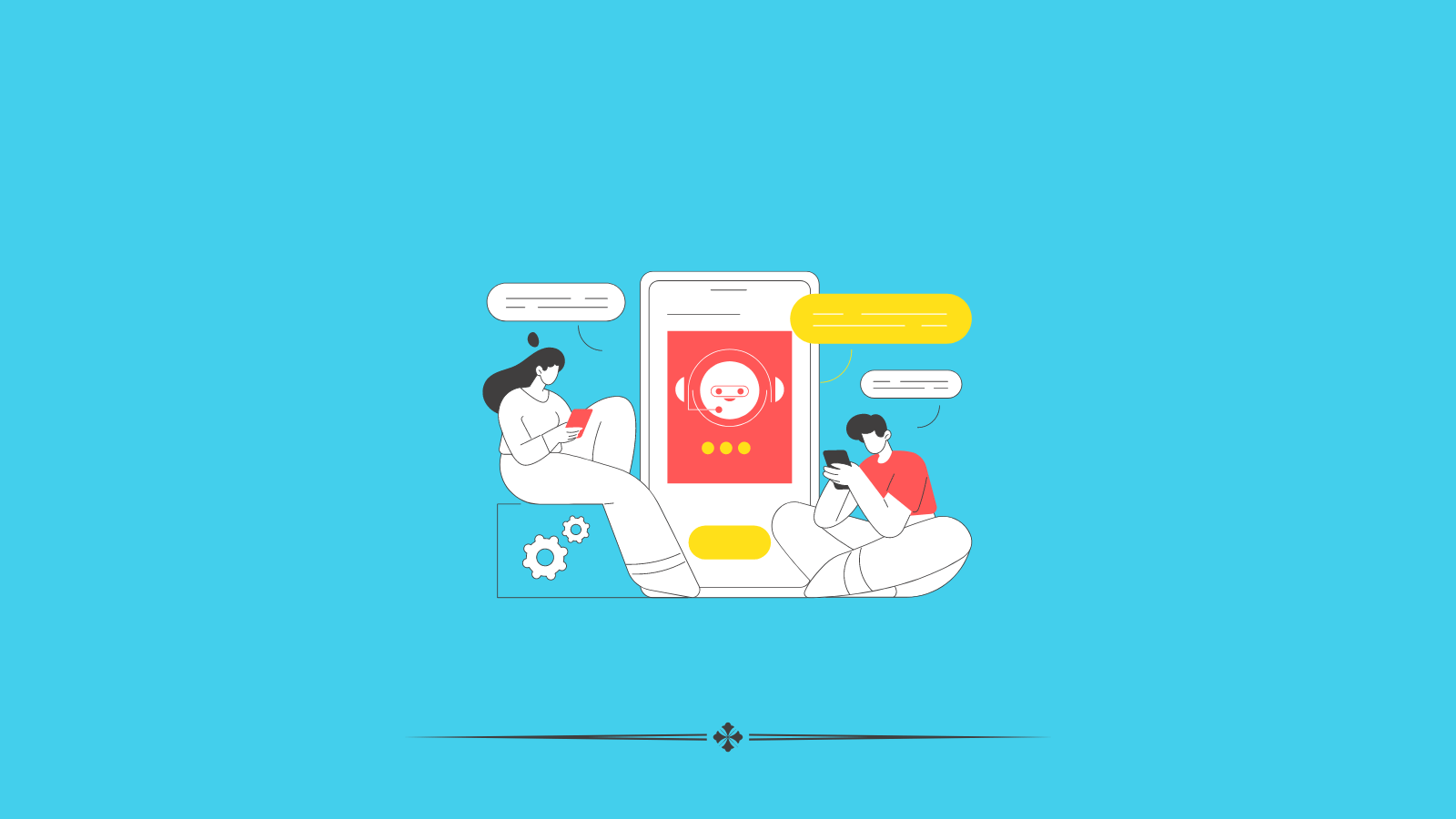
Chatbots have become an essential tool for businesses looking to improve customer service. Chatbots are automated systems powered by artificial intelligence (AI) that engage with customers in real-time, answering their queries, solving issues, and guiding them through various processes. For businesses, implementing chatbot tools can lead to improved efficiency, cost savings, and enhanced customer satisfaction. In this article, we’ll walk you through how to start implementing chatbot tools to boost your customer service.
Understand the Purpose of Chatbots for Your Business
Before diving into chatbot implementation, it’s crucial to define the purpose of the chatbot within your customer service operations. What are the key tasks you want the chatbot to handle? Here are some common applications:
- Answering Frequently Asked Questions (FAQs): Chatbots can address common customer inquiries about product details, shipping information, or return policies.
- Processing Orders and Payments: Chatbots can assist customers during checkout, processing orders, and providing secure payment options.
- Resolving Issues: They can help troubleshoot customer problems with products or services.
- Providing 24/7 Support: Chatbots ensure that customers can access support any time of the day, even when your human agents are unavailable.
Understanding your specific needs will guide you in designing a chatbot that meets your business objectives and improves the customer experience.
Choose the Right Chatbot Platform
The next step is selecting a chatbot platform that aligns with your business’s needs. There are many platforms available that allow businesses to create, customize, and deploy chatbots. Here’s what to consider:
- Ease of Integration: Ensure the chatbot platform integrates seamlessly with your website, e-commerce platform, CRM, or other tools you already use. Popular platforms like Zendesk, Drift, and Intercom are designed for easy integration.
- AI Capabilities: Look for platforms that support artificial intelligence and natural language processing (NLP). This enables the chatbot to understand and respond to complex customer inquiries.
- Customizability: Your chatbot should align with your brand’s tone and personality. Choose a platform that allows you to customize how the chatbot communicates and interacts with customers.
- Scalability: Ensure that the platform can scale with your business as you grow and require more advanced chatbot features or handle a larger volume of inquiries.
Create a User-Friendly Chatbot Experience
Once you’ve selected a platform, the next step is designing the chatbot experience. Keep the customer in mind throughout the development process to ensure that interacting with the bot is simple and efficient. Here are some best practices:
- Clear Welcome Message: Start with a friendly and clear introduction. The chatbot should immediately explain how it can help, such as “Hi! I can assist you with product inquiries, order tracking, or returns. How can I help you today?”
- Easy Navigation: Offer predefined options to guide users, such as buttons that say “Track Order,” “View Product Info,” or “Speak to Support.” This helps customers navigate quickly without needing to type detailed responses.
- Personalization: Incorporate the ability for the chatbot to personalize responses based on customer history, such as greeting the customer by name or suggesting products based on past purchases.
- Multilingual Support: If your business serves customers in multiple countries, consider a chatbot that can converse in different languages, offering localized customer service.
A smooth, user-friendly experience will ensure that your chatbot enhances rather than frustrates the customer service journey.
Train Your Chatbot with Customer Queries
To ensure your chatbot is useful and efficient, it needs to be trained to understand and respond to the most common customer queries. Start by analyzing your customer support tickets, emails, and chats to identify frequently asked questions. Common queries often include:
- Order status or tracking inquiries
- Questions about product details and availability
- Shipping and delivery times
- Return and exchange policies
Use this information to create a chatbot that can effectively respond to these inquiries. Additionally, ensure the chatbot can escalate complex or sensitive issues to a human agent when necessary. For instance, the bot might respond with, “I’m transferring you to one of our support specialists to assist further.”
Integrate the Chatbot with Live Support
While chatbots are powerful tools for automating customer service, there will always be situations where live human support is necessary. Ensure your chatbot is integrated with your live support team so that customers can be easily transferred to a human agent if the chatbot cannot resolve their issue.
Some platforms offer seamless transitions where the chatbot can log the conversation and pass it along to the live agent, ensuring no information is lost. This hybrid approach allows businesses to offer both automation and personalized support, leading to higher customer satisfaction.
Offer 24/7 Customer Support
One of the biggest advantages of implementing chatbots is the ability to offer 24/7 customer service. Unlike human agents, chatbots can handle customer inquiries at any time, even outside of traditional business hours. This ensures that customers always have access to support, no matter when they reach out. Chatbots can manage a wide range of tasks overnight, such as answering FAQs, handling order-related questions, or troubleshooting common problems.
Having round-the-clock support enhances the customer experience and reduces the pressure on your live agents during peak hours.
Monitor Chatbot Performance and Customer Feedback
After your chatbot is up and running, it’s important to continuously monitor its performance and gather customer feedback. Most chatbot platforms offer analytics tools that track key metrics, including:
- Response time: How quickly the chatbot answers customer inquiries.
- Accuracy: How well the chatbot understands and resolves customer questions.
- Engagement rates: How often customers engage with the chatbot versus live agents.
- Customer satisfaction: Feedback from customers after interacting with the bot.
Use these insights to optimize the chatbot’s responses, improve accuracy, and update its functionality. If customers report issues or frustration with the chatbot, be proactive in addressing these concerns and making adjustments to enhance its effectiveness.
Continuously Improve and Scale Your Chatbot
As your business grows, your chatbot should evolve as well. Continuously improve its functionality by adding more advanced AI capabilities, training it on new customer queries, and integrating it with more of your internal systems (such as your inventory or CRM). For example, if your chatbot initially focused on answering FAQs, you can expand its role to handle more complex tasks such as resolving technical issues or making product recommendations based on customer browsing behavior.
As customer demands and technology evolve, keeping your chatbot updated will ensure that it remains a valuable asset to your customer service strategy.
Promote the Use of Your Chatbot
Once implemented, it’s essential to promote the chatbot to ensure customers are aware of it and know how to use it. Make the chatbot visible and easy to find on your website, mobile app, or social media platforms. Include a pop-up or welcome message that invites visitors to engage with the bot, such as “Need help? Chat with us now!”
You can also promote the chatbot through email campaigns or other customer communication channels, explaining its features and how it enhances the customer service experience.
Implementing chatbot tools can significantly improve the efficiency and effectiveness of your customer service. By automating routine queries, providing 24/7 support, and enhancing the overall customer experience, chatbots free up human agents to handle more complex issues while ensuring customers receive timely responses. By following the steps outlined above—defining your chatbot’s purpose, selecting the right platform, training it with common queries, and continuously monitoring and improving its performance—your business can take full advantage of this powerful technology.
As chatbots become increasingly sophisticated, early adopters will gain a competitive edge in customer service, ultimately leading to higher customer satisfaction, loyalty, and growth.
FAQ
What are chatbot tools, and how do they enhance customer service?
Chatbot tools are software applications or platforms that use artificial intelligence (AI) to simulate human-like conversations with users. They enhance customer service by providing instant responses to customer queries, automating repetitive tasks, and offering personalized assistance round the clock.
How do chatbot tools assist businesses in providing real-time support to customers?
Chatbot tools assist businesses in providing real-time support to customers by instantly responding to their inquiries, regardless of the time of day or night. They handle common customer queries, troubleshoot issues, and escalate complex inquiries to human agents when necessary, ensuring prompt assistance.
What role do chatbot tools play in improving customer engagement and satisfaction?
Chatbot tools play a crucial role in improving customer engagement and satisfaction by offering personalized interactions, proactive assistance, and seamless experiences across various communication channels. They engage customers in meaningful conversations, address their needs promptly, and foster positive relationships with the brand.
How do chatbot tools streamline customer service processes and workflows?
Chatbot tools streamline customer service processes and workflows by automating routine tasks such as answering FAQs, processing orders, scheduling appointments, and handling customer feedback. They reduce response times, minimize manual intervention, and optimize resource allocation, leading to operational efficiency and cost savings.
What are the benefits of using chatbot tools for handling customer inquiries and support tickets?
The benefits of using chatbot tools for handling customer inquiries and support tickets include faster response times, increased scalability, improved consistency in responses, reduced wait times, and enhanced customer satisfaction. They enable businesses to handle large volumes of inquiries efficiently and deliver a seamless support experience.
How do chatbot tools leverage AI and natural language processing (NLP) to understand and respond to customer queries?
Chatbot tools leverage AI and natural language processing (NLP) to understand and respond to customer queries by analyzing the context, intent, and sentiment of the user’s messages. They use machine learning algorithms to continuously learn from interactions and improve response accuracy over time, enhancing the quality of customer interactions.
What role do chatbot analytics and insights play in optimizing customer service performance?
Chatbot analytics and insights play a crucial role in optimizing customer service performance by providing valuable data and metrics on chatbot usage, conversation patterns, user behavior, and customer satisfaction levels. They enable businesses to identify trends, identify pain points, and make data-driven decisions to enhance the chatbot experience.
How do chatbot tools integrate with other customer service channels and systems?
Chatbot tools integrate with other customer service channels and systems through APIs, webhooks, and integrations with popular CRM, helpdesk, and messaging platforms. They enable seamless data exchange and synchronization across channels, ensuring a unified customer service experience and efficient workflow management.
What are some examples of popular chatbot tools available in the market?
Examples of popular chatbot tools available in the market include Chatfuel, ManyChat, MobileMonkey, Drift, Intercom, Zendesk Chat, Freshchat, and HubSpot Chat. These tools offer a range of features such as customizable chatbots, omnichannel support, analytics, and integration capabilities to meet the diverse needs of businesses.
How can businesses leverage chatbot tools to build stronger customer relationships and drive business growth?
Businesses can leverage chatbot tools to build stronger customer relationships and drive business growth by delivering personalized, responsive, and efficient customer service experiences. By proactively addressing customer needs, resolving issues promptly, and providing value-added interactions, businesses can enhance customer loyalty, increase retention, and drive revenue growth.
Wrapping Up
Gone are days when a potential customer has to wait hours or even days to get their question answered. Chatbots offer a solution where customers are satisfied while keeping the customer support team empowered.
Think of it like a Swiss Army. From answering some basics to helping a customer complete a purchase, chatbot makes repetitive tasks easy. Now that you have a quick list of popular chatbot software in the market, you can choose the right one that meets your business needs, preferences, and budget.
Author
 Andre Oentoro is the founder of Breadnbeyond, an award-winning explainer video production company. He helps businesses increase conversion rates, close more sales, and get positive ROI from explainer videos (in that order).
Andre Oentoro is the founder of Breadnbeyond, an award-winning explainer video production company. He helps businesses increase conversion rates, close more sales, and get positive ROI from explainer videos (in that order).
Twitter: @breadnbeyond
Email: andre@breadnbeyond.com
More Tools to Help you reach your Goals Faster
- Best AI Pinterest Description Generators
- Best AI Instagram Caption Generators
- Top Social Media Marketing Tools for Nonprofits
- Best AI Social Media Caption Generators
- Best AI LinkedIn Caption Generators
- Best AI Facebook Caption Ganarators
- Best AI Twitter Caption Generators
- Best AI TikTok Caption Generators
- Why Chatbots?
- The difference between Chatbots and Conversational AI
- 8 Top Chatbot Software in the Market
- 1. Drift
- 2. Intercom
- 3. Tidio
- 4. LivePerson
- 5. Freshchat
- 6. ManyChat
- 7. Chatfuel
- 8. MobileMonkey
- How to Start Implementing Chatbot Tools to Improve Customer Service
- FAQ
- More Tools to Help you reach your Goals Faster
Jump back to a section
Create more and better content
Check out the following resources and Grow!